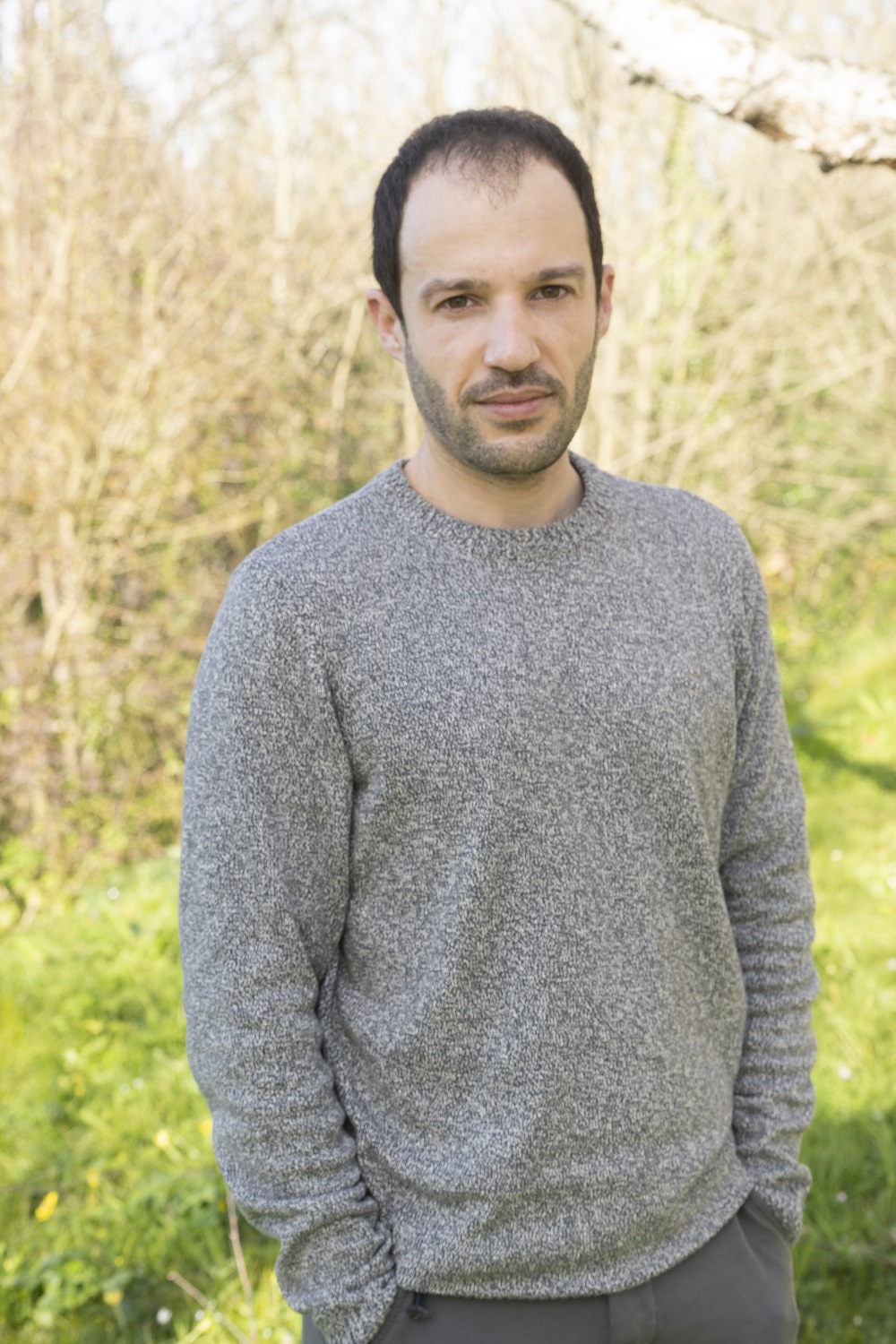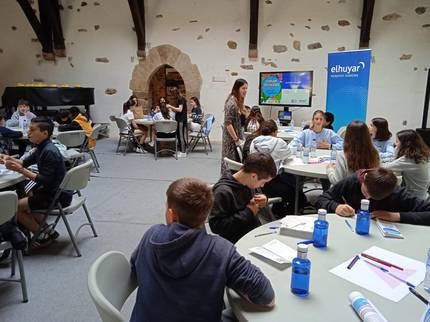“Conservation is not about educating the panda bear in zoos, but about maintaining and caring for the environment, even the closest one. And that environment can be a well next to our house and a school wall.”
2024/06/26 STEAM-Hezkuntza (Elhuyar Zientzia)
The students of ESO and Bachillerato of the Hernani BHI center, together with the researcher of Aranzadi Carlos Cabido Quintas, have observed the lizards to investigate their behaviors based on their morphotype within the project “Mesa de Gluones para inspirar los joven”.

Ph.D. in Biology, is a researcher at the Aranzadi herpetology team. Its specialty is animal behavior and evolutionary ecology. How do you explain your work?
In Aranzadi we have departments with very different subjects, where dissemination, conservation and research are carried out, mainly with regard to the conservation of the environment. That's where I settle. In the studies, I have combined the analysis of ecological and behavioural aspects, and I have analyzed their relationship with the conservation status of the species and with the environment.
My department is called herpetology. Herpets are dragged animals. Includes amphibians and reptiles. In fact, they have nothing to do with each other; it would be like introducing birds and spiders into the same group, but historically this has been done, and in Aranzadi it is also done like this.
Where does the interest in amphibians and reptiles come from?
Since I was a kid, I liked to look at amphibians and reptiles. Animals observable at the naked eye. However, science has not researched as much as other species and, temporarily, they are not as attractive as others. Birds, for example, will come out on the mountain and look more easily than reptiles. Once the reptiles are observed, simply by looking at them, they can be observed very closely, without influencing their comportamiento.La laboratory research is also simpler than that of birds.
What is the importance of investigating “herpets”?
All the importance and nothing. It is believed that a specific objective should be investigated. “Whatever is important to control pests.” That is, the species in question should have a specific function to be investigated. Subsidized policies also work in this way.
I believe, however, that species have an intrinsic value, because they are the result of evolution. Moreover, we can understand it from an artistic point of view, because we believe that works of art are the excellence of human culture, even if they do not have any practical function. With species we can act in the same way, they are treasures that have come to us and that deserve our attention and our conservation effort.
The questions about why we need to do research on herpets and why we need to do science have the same answer, to understand how the world works. To do this, it's best to do basic science without applications, because we don't know when and where there's going to be useful knowledge. So, everything we do research will have its value in this world.
What is the state of amphibians and reptiles? Why is conservation important?
They are among the most threatened species among vertebrates. At least 50% of the world's amphibian species have some threat. In the case of birds, I think it does not reach 20%, but the effort being made for their conservation is much greater. I do not mean that birds should not be investigated, but the difference is clear.
Through the Mesa de Gluones project, you have launched your research project in schools. In this case, she has worked with young people from the IES Hernani. What have you done?
I've long been interested in the influence of lizard morphotypes on their attitudes, and I thought young people could collaborate in this research. In Euskal Herria, we have a very typical lizard, a mural lizard, and in many schools are the stone walls where they live. The Hernani BHI Institute was the right one for this purpose.
In this case, male lizards have been observed. During the period of heat, the males of this species present ventral colors orange, white or yellow. Some of them are territorial and protect their area, the most populated of females. On the other hand, there are also lizards that enter the area of the outlawed with the aim of “stealing” the females. They try to go unnoticed and they don't get as many females as landowners do. They do not spend energy defending the territory. And finally, instead of territory, there are also snakes that defend their female. I mean, they copulate with a female and stay next to her so that another male doesn't join her.
The behaviour of these lizards has been observed. I would say it's an attractive activity. After all, it's seeing insects. It is often thought that the scientist who investigates the wolf has a very interesting job, but it must be borne in mind that a very high percentage of those who investigate the wolves are engaged in collecting the excrement of the wolf. . However, our research allows us to observe their behavior in the field.
In addition, it should be noted that it is very good for us that young people carry out this research. In other words, the collected data will have a real use for us to study them and, if they so wish, publish them. I mean, they've done the real science of citizenship. Because of that, you've seen what science really is. That is precisely what Elhuyar wants to achieve with this project.
What has the process been like? What steps have you taken?
We went to give them an explanatory session to start the research, and we explained what we were going to do. It should be mentioned that we were unable to complete the planned timetable; in February spring days were experienced and after Easter, when we had to start the observation, the cold came back. The Aranzadi had to mark the lizards ahead to be identified in the observation. It was not possible.
As for the process, the first thing that should be done is to explain what the phenomenon is and that the young people themselves consider how to analyze it. I mean, that would be the ideal way to understand how science really works. That is, science is about asking questions and looking for methods to get evidence-based information to solve them. We have not had time to do this, but at least they have realised the importance of applying the scientific method, that we have to be rigorous, that we have to take data systematically, etc.
They have been given a protocol adapted to each age group. The younger ones have picked up the lizards in a photo taken to the wall. And if you approach the other lizards.
However, the more mature have analyzed the behavior of the lizard in the face of a threat. Young people have gradually approached the lizard and have measured, by means of chronometers and laser meters, when they have escaped. And how long does he leave his hiding place? It must be taken into account that the lizard needs sun to maintain the temperature, so it will have to leave after a while.
With all this, we want to show you that with simple measures you can analyse complex behaviors.
I would like to stress that, as regards environmental awareness or environmental education, working with common and accessible species has been an opportunity to highlight the importance of conservation. They've realized that behind the invisible look of lizards lies a complex species. Conservation is not about educating the panda bear in zoos, but about maintaining and caring for the environment, even the closest one. And that environment can be a well next to our house and a school wall.
Young people will present the results of research at fairs in Bilbao. How important is that?
Having to explain them will force them to better understand what they are doing and will generate questions and doubts. In other words, it is better to create questions than to end the research with certainty. The goal is for you to look at the world through questions. Instead of saying, "Look at what a weird bird," say, "Why is it weird?"
To delve deeper into the project, download the brochure "Sustainability Research to Inspire Young People" here.
This project, promoted by Elhuyar, has the collaboration of the Department of Economic Promotion and Strategic Projects of the Provincial Council of Gipuzkoa.

Gai honi buruzko eduki gehiago
Elhuyarrek garatutako teknologia





